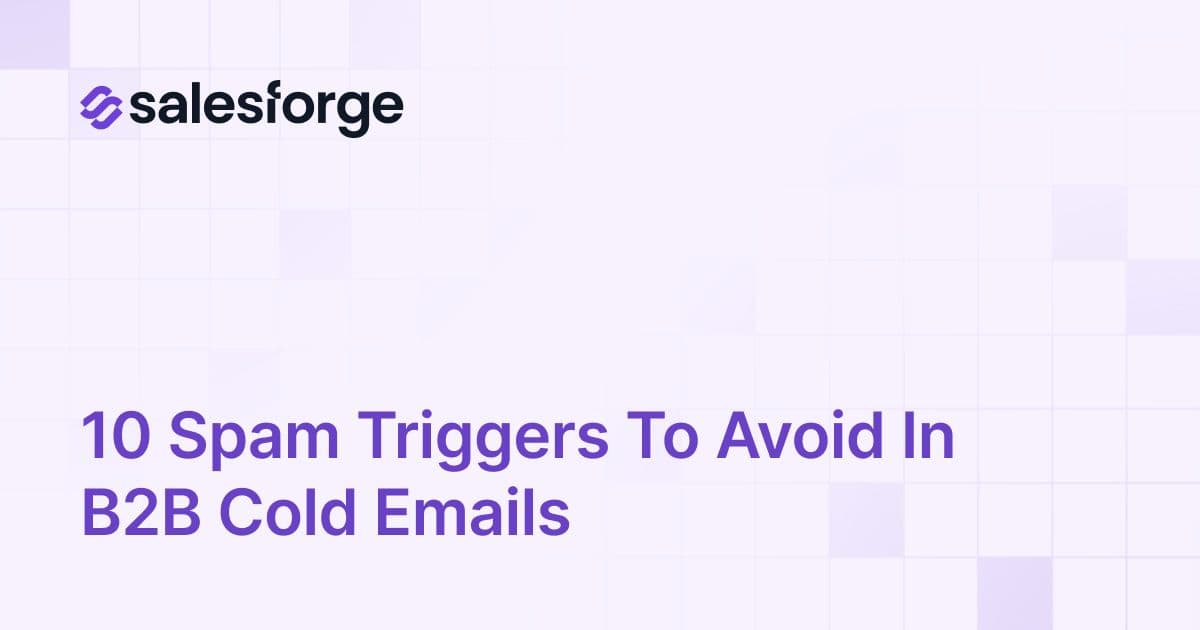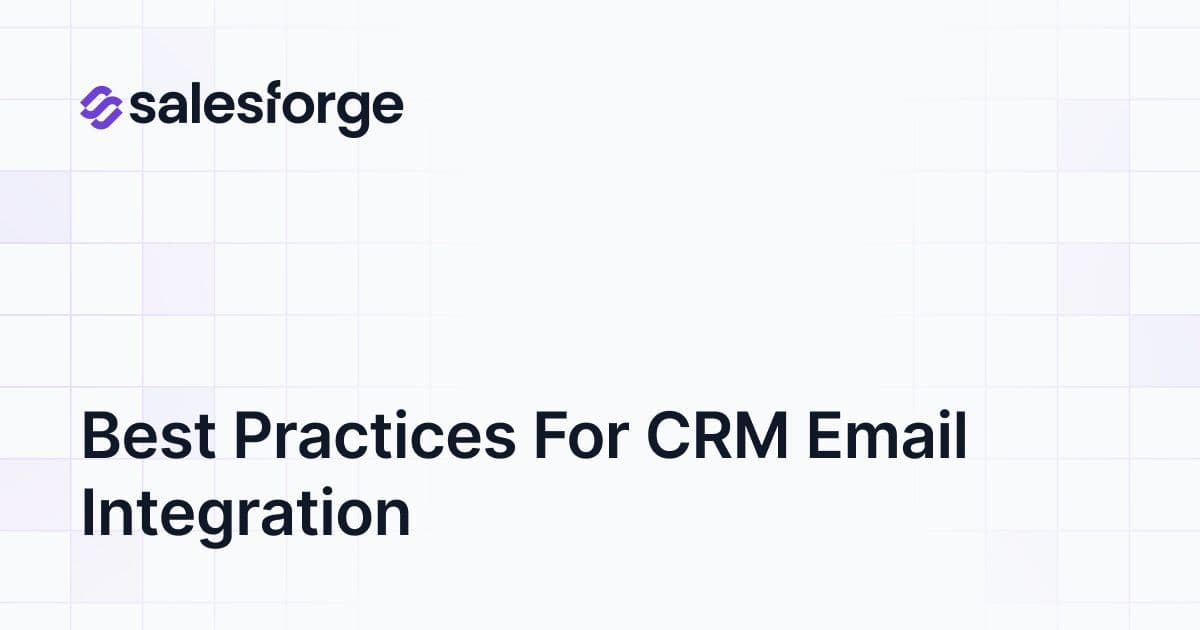How AI SDRs Improve Workflow Efficiency
AI-powered SDRs (Sales Development Representatives) are transforming sales workflows by automating repetitive tasks, improving personalization, and enabling teams to focus on closing deals. These tools use advanced technologies like natural language processing (NLP) and machine learning to:
- Automate tedious tasks like prospecting, follow-ups, and email crafting.
- Deliver personalized outreach at scale, boosting engagement and response rates.
- Monitor real-time engagement metrics to optimize messaging and timing.
- Reduce errors like duplicate emails or missed follow-ups.
Top tools like Agent Frank, Seamless.ai, Markopolo, and Luru AI each bring unique features to the table. While Agent Frank offers end-to-end multi-channel automation, Luru AI focuses on improving post-conversation tasks. Choosing the right tool depends on your team’s needs, whether it’s hands-off automation or a balance of automation with human input.
AI SDRs vs. Traditional SDRs: How Workflow Efficiency Has Changed
For years, traditional SDRs (Sales Development Representatives) have relied on manual, time-intensive processes that often slow down sales teams. From researching prospects to crafting personalized emails and tracking everything on spreadsheets, these methods tend to pull SDRs away from their ultimate goal: closing deals.
The Traditional SDR Challenge
Traditional SDR workflows come with their fair share of hurdles. Tasks like researching prospects, writing customized messages, and managing follow-ups are not only time-consuming but also prone to errors. These errors - whether it’s sending duplicate emails or forgetting to follow up - can harm a company’s reputation. While personalized communication is essential to building relationships, creating tailored content for large prospect lists is a daunting task that limits the number of leads an SDR can effectively engage.
How AI SDRs Transform Workflow Efficiency
Enter AI SDR platforms, which tackle these challenges head-on by automating repetitive tasks and streamlining workflows. These tools analyze massive amounts of prospect data in seconds, enabling targeted outreach strategies that would take traditional SDRs hours, if not days, to develop. This allows sales teams to connect with more prospects in significantly less time.
AI tools also monitor engagement and conversion metrics in real time, adjusting messaging, timing, and follow-up sequences on the fly. Unlike the slower, periodic reviews typical of manual processes, this real-time optimization ensures that outreach efforts stay timely and relevant.
The Automation Advantage
AI SDR platforms shine when it comes to managing multi-channel campaigns. They automate follow-ups, track interactions, and keep records up to date, reducing the chances of human error. With real-time access to prospect interaction histories, teams can manage leads more effectively and maintain consistent communication.
Personalization at Scale
One of the standout benefits of AI SDRs is their ability to deliver personalized messaging at scale. By leveraging a wide range of data points, AI ensures that each message feels tailored, even when sent to thousands of prospects. This not only boosts response rates but also leads to more meaningful conversations.
In short, AI SDRs represent a major leap forward from the manual, labor-intensive methods of traditional SDRs. By combining automation, data-driven insights, and scalable personalization, these tools empower sales teams to work more efficiently and strategically. This shift sets the stage for exploring the top AI SDR tools available today.
<script>(function(d,u,ac){var s=d.createElement('script');s.type='text/javascript';s.src='https://a.omappapi.com/app/js/api.min.js';s.async=true;s.dataset.user=u;s.dataset.campaign=ac;d.getElementsByTagName('head')[0].appendChild(s);})(document,372145,'tu1or50rqqejh816h1cm');</script>
1. Agent Frank by Salesforge
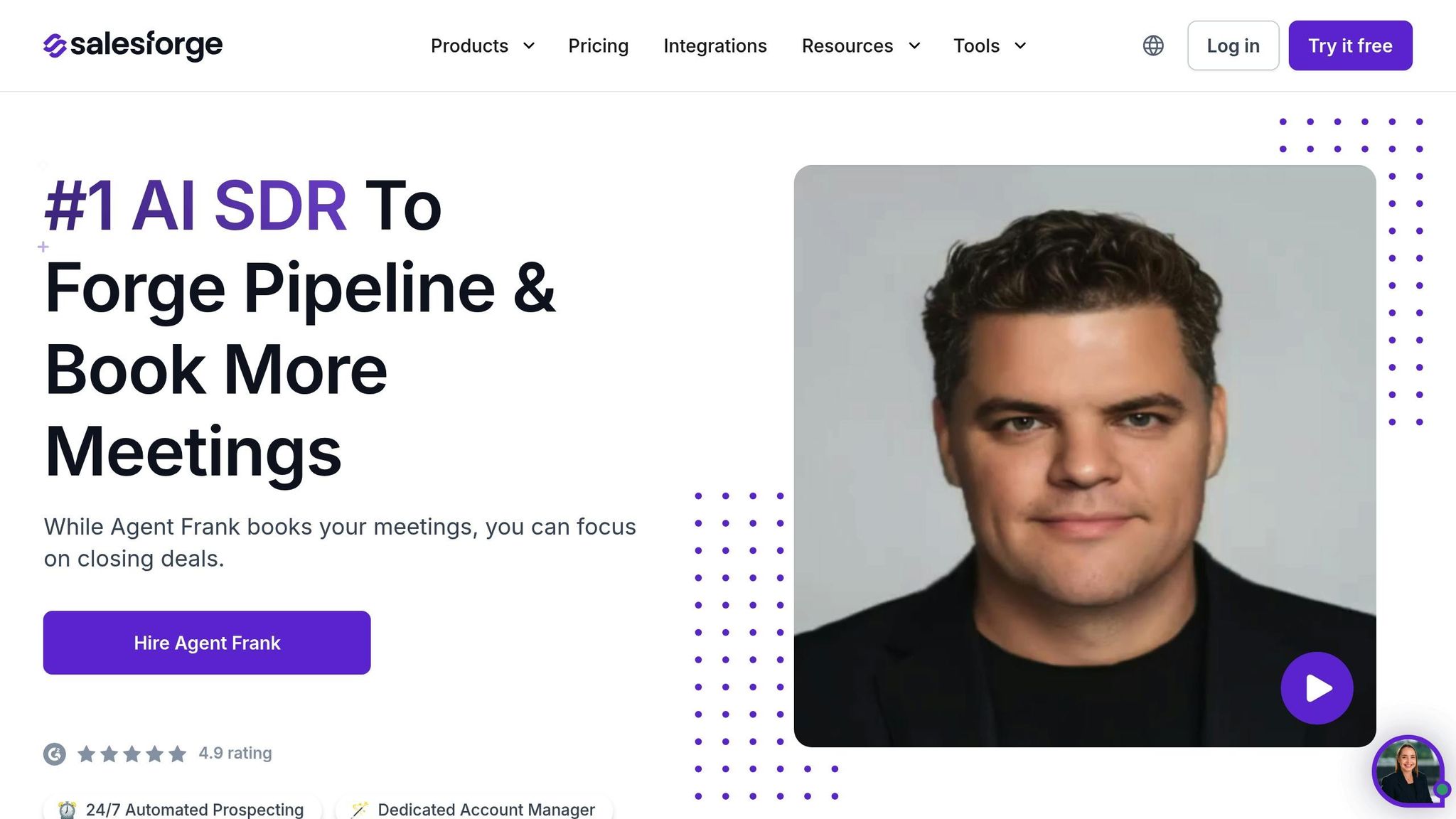
Agent Frank is Salesforge's AI-powered SDR (Sales Development Representative) solution designed to handle the entire sales development process - from finding leads to scheduling meetings. Unlike traditional SDRs who juggle multiple manual tasks, Agent Frank simplifies and automates the outreach process.
Task Automation
Agent Frank takes over time-consuming tasks like lead generation, qualifying prospects, crafting customized messages, managing follow-ups, and even booking meetings directly on calendars. By automating these steps, sales teams can shift their focus to closing deals instead of getting bogged down by administrative work.
It works seamlessly with Salesforge's email infrastructure, combining mailbox management with Warmforge's email warm-up tools. This integration eliminates the hassle of switching between multiple platforms, offering a streamlined and efficient approach to sales outreach.
Personalization at Scale
Agent Frank excels in delivering personalized communication at scale. Using AI, it crafts tailored messages for each prospect, ensuring they feel relevant and genuine. It also supports multilingual outreach, allowing teams to connect with prospects worldwide in their native languages.
Data Accuracy
To enhance outreach effectiveness, Agent Frank includes built-in email validation. This ensures prospect data is accurate before any communication begins, reducing the risk of bounced emails and safeguarding sender reputation. With cleaner data, sales teams can achieve better email deliverability and improved results.
Impact on Revenue
By automating repetitive tasks and maintaining consistent follow-ups, Agent Frank helps sales teams increase their outreach volume without overextending resources. It operates around the clock, ensuring no opportunity is missed. This not only boosts the number of qualified meetings but also strengthens the overall sales pipeline, leaving human teams free to focus on what they do best - closing deals.
2. Seamless.ai
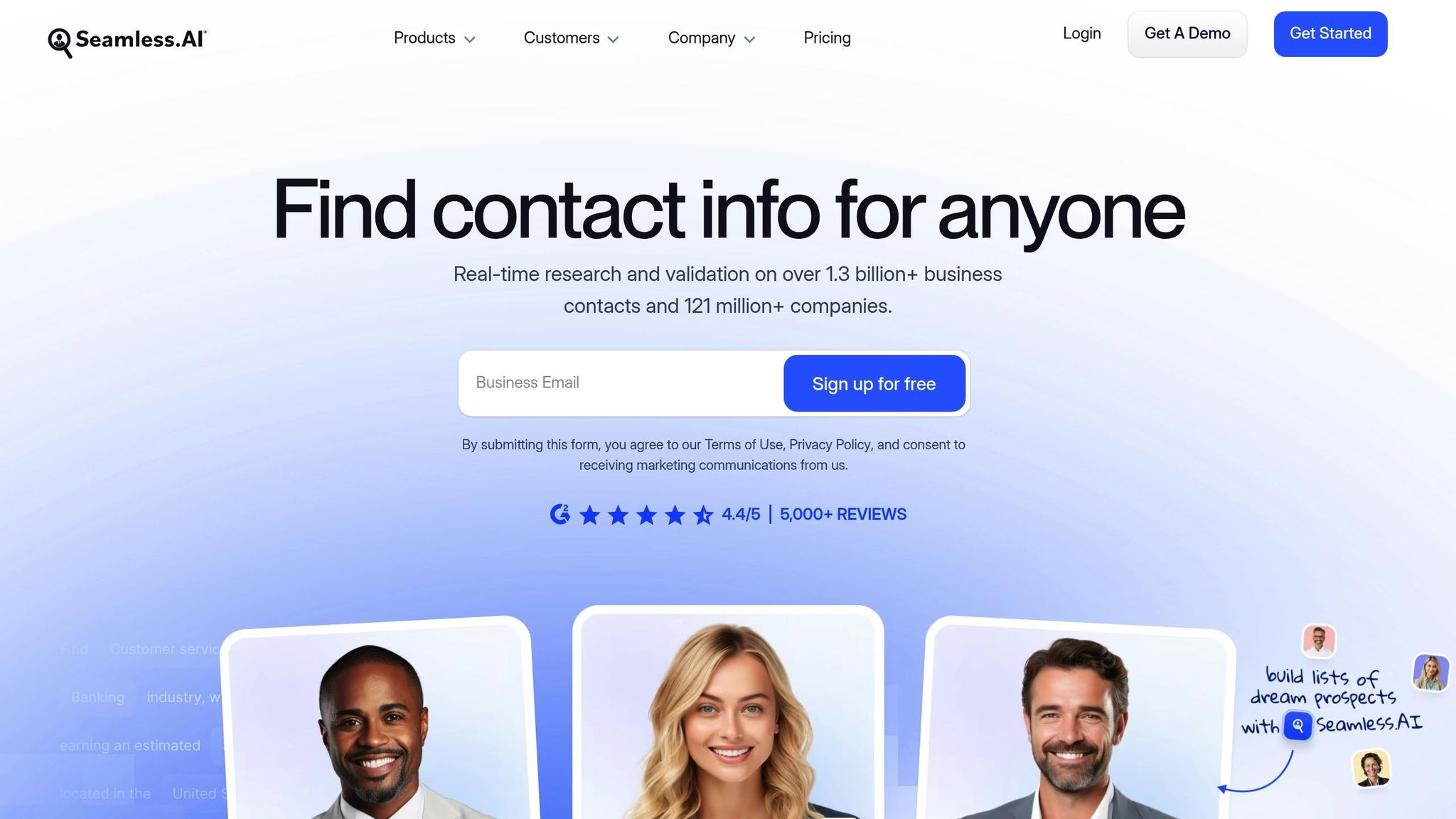
The claims made by Seamless.ai about automating sales development tasks - such as streamlining workflows, ensuring data accuracy, and boosting revenue - are not independently verified by external sources.
To decide if Seamless.ai aligns with your sales development goals, it’s essential for sales teams to conduct their own thorough review and demo of the platform. Taking this step allows you to assess its effectiveness and compare it with other AI-powered SDR tools on the market.
3. Markopolo

Markopolo is an AI-driven marketing automation platform designed to improve sales outreach by refining data management and expanding marketing efforts.
Keeping Data Accurate
Markopolo uses AI algorithms to verify and update contact information, ensuring lead profiles stay current. By cleaning out outdated details, it helps reduce email bounce rates and boosts deliverability. This focus on maintaining a reliable database lays the groundwork for better performance and measurable results.
Revenue Considerations
While Markopolo’s emphasis on data accuracy is a strength, its broader marketing scope makes it harder to directly connect its efforts to revenue outcomes. On the other hand, specialized AI tools like Salesforge's Agent Frank focus on streamlining sales processes, offering a clearer path to tracking ROI.
4. Luru AI
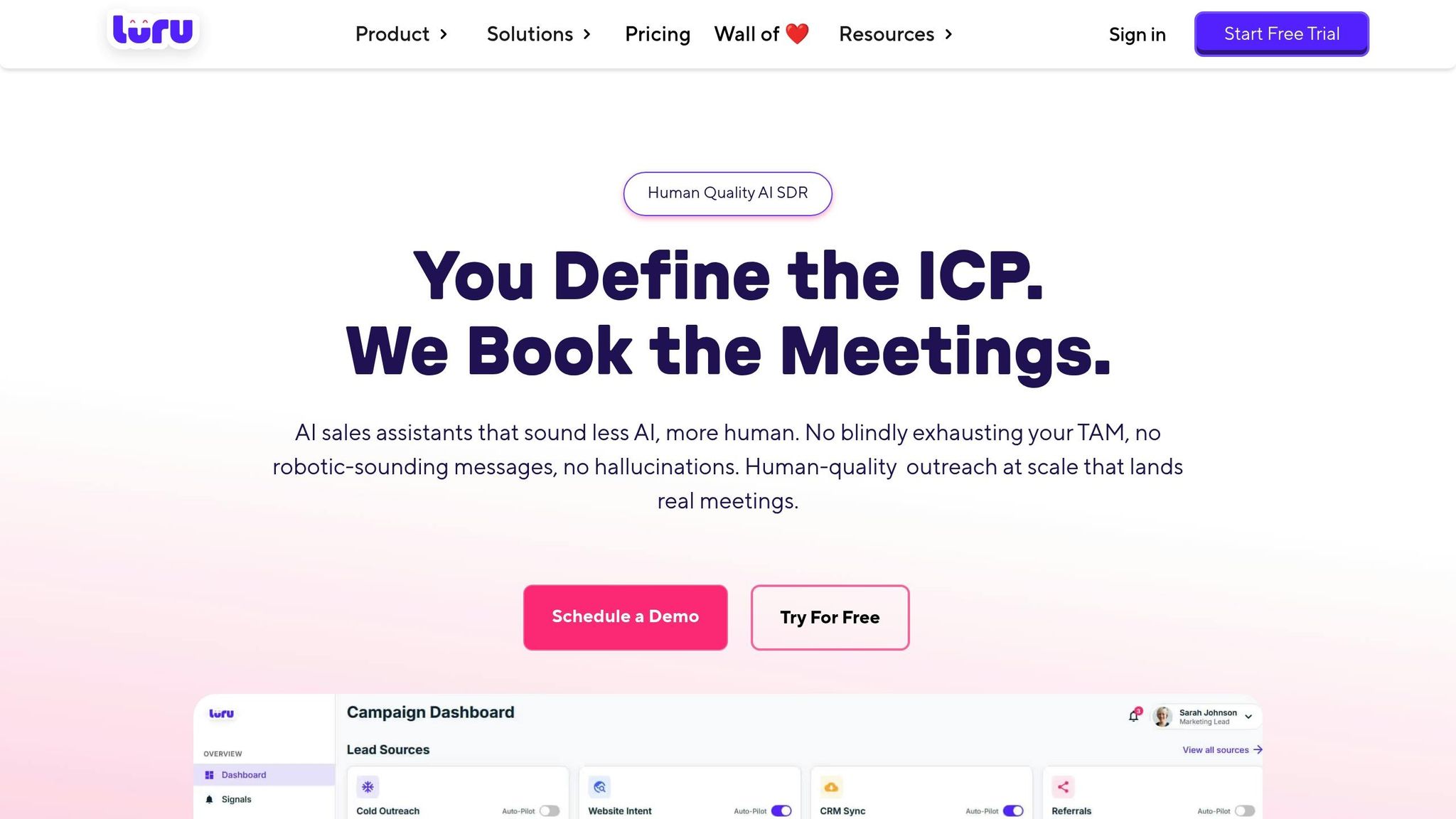
Luru AI is a conversation intelligence tool designed to refine and enhance sales interactions after the initial contact stage. Unlike AI tools that manage the entire outreach process, Luru AI zeroes in on improving the quality and efficiency of conversations that follow the first connection.
Task Automation
One of Luru AI's standout features is its ability to handle time-consuming post-conversation tasks. It captures meeting notes, extracts actionable insights, and updates CRM records automatically. By integrating with major CRMs and conferencing platforms, it eliminates the repetitive data entry work that often eats up an SDR's time.
The platform goes a step further by identifying action items, follow-up tasks, and next steps directly from recorded conversations. These are then turned into calendar reminders and task assignments, saving sales teams from manually reviewing call recordings or transcribing key points. This automation allows SDRs to focus their energy on more strategic activities.
But Luru AI doesn't stop at automation - it also helps sales teams personalize their follow-ups effectively.
Personalization at Scale
While Luru AI doesn't create initial outreach messages like Agent Frank, it excels at making follow-ups more tailored and impactful. By analyzing conversation patterns and buyer preferences, it pinpoints which talking points resonate most with different types of prospects. This insight enables sales teams to craft follow-up messages that feel more relevant and customized.
The platform also tracks engagement levels and sentiment throughout the sales cycle, helping SDRs determine the best times to engage prospects with specific messaging strategies. This data-driven approach ensures that follow-ups align with each prospect’s interests and communication style, increasing the likelihood of meaningful engagement.
Impact on Revenue
Although Luru AI improves efficiency and personalization, its direct impact on revenue can be harder to measure. The platform focuses on optimizing conversations that are already in motion, rather than addressing top-of-funnel activities like cold outreach or lead generation.
This makes Luru AI different from tools like Salesforge’s Agent Frank, which ties outreach efforts directly to revenue outcomes. Instead, Luru AI specializes in refining post-contact interactions, ensuring that these conversations are as effective and productive as possible. While this approach doesn’t tackle the challenges of initial prospecting, it provides a valuable boost to the later stages of the sales process, where strong conversations can make all the difference.
Advantages and Disadvantages
AI-powered SDR tools come with their own set of strengths and limitations. The key is finding the one that aligns best with your team's goals and workflow.
Agent Frank by Salesforge stands out for its multilingual personalization across email and LinkedIn and advanced AI-driven data analysis. It creates highly tailored email sequences based on a prospect's industry, role, and engagement patterns. Plus, its "Auto-Pilot" mode handles everything - from prospecting and outreach to follow-ups and scheduling - without any human input.
Luru AI, on the other hand, focuses on intent-based outreach. By analyzing prospect behavior and engagement signals, it crafts messages that feel personal and natural. While this approach ensures high-quality communication through mandatory human review, it can slow down the overall workflow.
Here’s a quick breakdown of their differences:
- Agent Frank: Fully autonomous, multilingual personalization.
- Luru AI: Combines automation with human oversight for quality control, though at a slower pace.
Ultimately, the choice depends on your priorities. If you’re looking for hands-free automation, Agent Frank might be the way to go. For those who value a balance of data-driven outreach with human quality checks, Luru AI could be the better fit. Both tools aim to strike a balance between personalization and efficiency in modern sales workflows.
Conclusion
The shift from traditional Sales Development Representatives (SDRs) to AI-driven solutions marks a significant transformation in how sales teams enhance workflow efficiency. While human SDRs excel in creativity and building relationships, AI SDRs stand out for their reliability, round-the-clock availability, and ability to scale prospect management effortlessly.
Among the tools reviewed, Seamless.ai, Markopolo, and Luru AI each offer distinct advantages tailored to different sales development needs.
What makes Agent Frank stand out is its capacity to autonomously manage the entire sales development process. From generating leads and crafting personalized messages to handling follow-ups and scheduling meetings, Agent Frank integrates multilingual AI-driven personalization, making it especially appealing to companies targeting international markets. For teams wanting a fully hands-off solution that balances efficiency with personalization, Agent Frank is a strong contender. On the other hand, tools like Luru AI cater to teams that prioritize human oversight in their workflows.
Ultimately, success with AI SDRs hinges on choosing a platform that aligns with your team’s specific processes and objectives, rather than opting for the one with the longest list of features.
As our analysis highlights, the future of sales development lies in leveraging AI to handle repetitive tasks, giving human talent the freedom to focus on closing deals. Adopting AI SDRs today can provide a competitive edge in tomorrow’s sales landscape.
FAQs
How do AI SDRs like Agent Frank verify prospect data to ensure accurate outreach?
AI SDRs, such as Agent Frank, rely on advanced tools powered by artificial intelligence to validate prospect data before starting outreach. These tools check critical details like email addresses and phone numbers, ensuring the contact information is current and accurate, which helps cut down on errors.
By automating this validation process, AI SDRs help improve email deliverability, reduce the number of bounced emails, and streamline outreach efforts. This means your messages are more likely to land in the right inboxes, saving time and increasing efficiency in your sales workflow.
How Do AI SDRs Work?
Fully autonomous AI SDRs take care of tasks like lead generation, outreach, follow-ups, and even scheduling meetings - all without human intervention. By automating these repetitive activities, businesses can save time and expand their outreach efforts with minimal effort. These systems are perfect for handling high-volume, routine tasks, making workflows smoother and more efficient.
In contrast, AI SDRs with human oversight operate as a collaborative tool for sales teams. The AI handles the initial outreach and follow-up processes, while sales professionals step in for more nuanced tasks like handling objections, navigating complex conversations, and building relationships. This approach prioritizes quality interactions but may not move as quickly as fully autonomous systems.
Choosing between these two models comes down to your sales goals. If speed and scalability are your focus, fully autonomous systems might be the way to go. However, if personalized engagement is key, a hybrid approach with human oversight could deliver better results.
What should sales teams look for in an AI SDR tool to ensure it meets their goals?
Sales teams need to pay close attention to how effectively an AI SDR tool can take over repetitive tasks like lead qualification, outreach, and follow-ups. The best tools should handle these tasks efficiently at scale, work 24/7, and fit seamlessly into your current sales workflows and CRM systems.
It's also important to assess features like AI-driven personalization, multi-channel outreach capabilities, and how well the tool aligns with your specific sales goals. Tools that improve over time through learning can offer lasting benefits by enhancing performance and keeping pace with changing business demands. Focus on solutions that simplify your processes and deliver clear, measurable outcomes.

